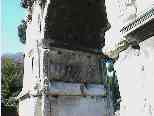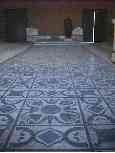Breakfast at the Hotel Alimandi: Lots of different cookies, rolls, a sweet cake, soft boiled eggs, preserves, cheeses, coffee, tea...
Rome's subway looks like New York City's subway in the 1960's.
The cars are not air conditioned, and the city is not well covered.  Still,
it gets us from the hotel to a stop across from the Colosseum. You
mount the stairs into the sunlight, and there it is, directly across the
street! To me, the most surprising aspect of the Colosseum is the depth
of the floor below the "stage". It looks like 20+ feet deep, with
rooms for prisoners, gladiators, wild animals, etc. According to
Gene, contestants would be lifted to stage level through trap doors.
That's a long lift!
Still,
it gets us from the hotel to a stop across from the Colosseum. You
mount the stairs into the sunlight, and there it is, directly across the
street! To me, the most surprising aspect of the Colosseum is the depth
of the floor below the "stage". It looks like 20+ feet deep, with
rooms for prisoners, gladiators, wild animals, etc. According to
Gene, contestants would be lifted to stage level through trap doors.
That's a long lift!

Gene's introduction to the Colosseum |

An overview shot of the Colosseum |

Notice the depth of the Colosseum floor beneath the "stage" level. |

An ancient Roman arch frames modern Roman traffic. |
 We
then walk to the Forum, past the Arch of Constantine, celebrating the Roman
Empire's conquest of Palestine, and having looted The Temple in Jerusalem.
We
then walk to the Forum, past the Arch of Constantine, celebrating the Roman
Empire's conquest of Palestine, and having looted The Temple in Jerusalem.
The most impressive remaining structures are the Basilica Maxentius (three of six arches remain) and the Senate. The Senate (albeit reconstructed) is largely intact. The marble floor is in very good condition. The building is quite tall, but much smaller in footprint than one would imagine from Hollywood portrayals.
 We
walk down to the Pantheon. This is a truly impressive structure,
particularly from the inside (sorry, but my camera just couldn't do it
any justice). Built in 120 AD, it was a one-stop shop for worshipping
the Roman gods. The altars for these gods were converted for worship
of saints after Constantine converted the empire to christianity.
The building is a cylinder, 140 feet in diameter, topped by a hemisphere
(truncated at the top) that is 70 feet in radius. The top few feet
are open to the sky (termed an "oculus" because it makes the dome look
a little like an eyeball?). When the sun is shining (as it is today),
it makes a spectacular shaft of light, which Gene refers to as the biggest
and most beautiful column in Rome. Note that the dome is open to
the sky, to permit easier communication with the gods. Of course,
this also permits communication of precipitation, but the floor is set
up to drain rapidly.
We
walk down to the Pantheon. This is a truly impressive structure,
particularly from the inside (sorry, but my camera just couldn't do it
any justice). Built in 120 AD, it was a one-stop shop for worshipping
the Roman gods. The altars for these gods were converted for worship
of saints after Constantine converted the empire to christianity.
The building is a cylinder, 140 feet in diameter, topped by a hemisphere
(truncated at the top) that is 70 feet in radius. The top few feet
are open to the sky (termed an "oculus" because it makes the dome look
a little like an eyeball?). When the sun is shining (as it is today),
it makes a spectacular shaft of light, which Gene refers to as the biggest
and most beautiful column in Rome. Note that the dome is open to
the sky, to permit easier communication with the gods. Of course,
this also permits communication of precipitation, but the floor is set
up to drain rapidly.
The group disperses, and we head to the Piazza Navona. I withdraw
some lire from an ATM (definitely the way to go! Much less hassle,
excellent exchange rate, and a fee of only $3.), and we have  lunch
on the piazza:
lunch
on the piazza:
- mozzarella with cold spinach and tomatoes;
- spaghetti ala carbonara;
- salad with wurstël (which turns out to be bits of frankfurter, but pretty flavorful), olives, and cheese;
- some more fruscatti wine
We walk to see the Cappuccin Crypt, but it's closed for siesta, until 3 PM. That's too late for our schedule.
While hiking around Rome, we encounter:
- Sidewalk cafes, set up on a busy sidewalk perhaps 5 feet wide. People are sitting, enjoying their meals, while pedestrians squeeze around them, and scooters and cars zip by just feet away.
- A spectrum of water fountains, from functional drinking fountains to ornamental ones like the Trevi, are liberally sprinkled around Rome. All of them get a lot of use. The drinking fountains don't have faucets -- they simply run continuously. Everyone uses them. Near the Cappuccin Crypt, I watch a couple of examples:
- One woman cleans her hands in the stream, and then cups them together to drink;
- A well-dressed man in a business suit daintily places one hand into the stream and flicks the water off a few times before cupping it into the stream and drinking.
When in Rome... We filled our water bottle from the drinking fountains, and later on, I was very glad for the opportunity to wash my hands in a fountain in the Piazza San Pietro after a long sweaty climb to the dome.
St. Peter's Church may be the largest work of art ever built. It is a testament to the power (financial, propagandistic, etc.) of the Catholic church during the Renaissance. That they were able to get Brunelleschi and Michelangelo to design the church is an incredible bit of luck. The Catholic order paid a very dear price for this edifice. The indulgences they sold may have helped pay for it, but they also triggered the Lutheran Reform movement that split the Church and Europe.
 As
you enter, the first thing you notice is the immensity. The immense
bronze altar is dwarfed by the basilica alone, much less the transcepts
and domes. Michelangelo's famous Pieta (which I remember seeing when
the Vatican brought it to their pavilion at the NYC World's Fair in 1964
-- how could they possibly have taken that risk?) is immediately to the
right of the entrance. It looks slightly smaller (and yellower) than
I remember it, but then I was only 9 years old at the time, and they might
have given it a special cleaning for the event.
As
you enter, the first thing you notice is the immensity. The immense
bronze altar is dwarfed by the basilica alone, much less the transcepts
and domes. Michelangelo's famous Pieta (which I remember seeing when
the Vatican brought it to their pavilion at the NYC World's Fair in 1964
-- how could they possibly have taken that risk?) is immediately to the
right of the entrance. It looks slightly smaller (and yellower) than
I remember it, but then I was only 9 years old at the time, and they might
have given it a special cleaning for the event.
Peter (yes, that Peter) is supposedly buried beneath the church, directly below the symbolic coffin to the east of, and below the bronze altar at the center of the basilica. There are an awful lot of other dead popes buried here. Some of them appear to be preserved and viewable. Tastes certainly change...
While Brigid attends mass, I roam about, and climb to the dome and cupola
(L5,000 w/o elevator, L6,000 with). The climb is not particularly
difficult, but it does generate some sweat. The view at the base
of the dome is incredible. From here, you realize that the entire
inside of the dome is covered in mosaics -- the whole huge dome!
And much of the rest of the church, for that matter. Then you climb
to the cupola at the apex of the dome, using stairs that proceed between
the internal and external domes. These are very weird stairs.
The final ascent is on a very tight (3 1/2 feet in diameter?) spiral staircase.
The view from the top is incredible, and not to be missed.
Afterwards, Brig and I rendezvous at the obelisk at the center of P. S. Pietro, and hike back to the hotel in time for a shower and change of clothes. Then we rejoin the group in the restaurant atop Hotel Alimandi, for dinner:
- bruschetta with tomato and garlic;
- fresh mozzarella and tomatoes;
- spaghetti pomodoro, with parmesan;
- thin steaks, marinated in olive oil and garlic, and then grilled;
- mixed salad;
- potatoes cooked with bell peppers;
- more fruscatti wine;
- gelati (chocolate and vanilla)
After dinner, I noticed a 3 inch refractor telescope pushed to one side. I asked about it, and Mr. Alimandi happily dragged it out. He said that they usually use it to view the moon. The moon hadn't risen yet, but Jupiter was sitting high in the sky above the Vatican. Mr. Alimandi found the eyepiece and attempted to fit it. Apparently, the setscrew was missing. He tried to use a napkin as a shim, to keep the eyepiece in place, but it was too thick. I remembered a hard candy in my pocket. Its wrapper made a perfect fit. No focusing mechanism, though. I manually focus, after lining up Jupiter without the aid of a finder scope. They eyepiece has a magnification of 80 or 90X, so it's very frustrating. Eventually I get it lined up. The scope's optics are great: Three Galilean moons are visible, and it is easy to see banding on the planet's "surface". Several of the tour members, and Mr. Alimandi, took a look. (I had to readjust the scope in both axes between each viewing, since the mount was not aligned properly.)
A very satisfying day.











